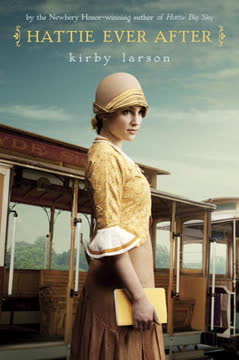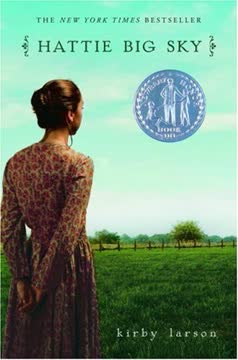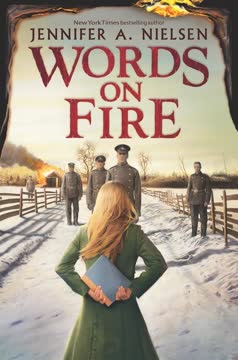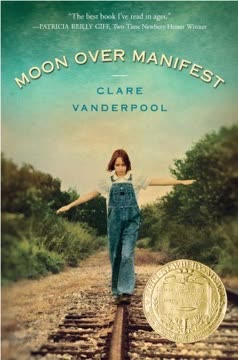Plot Summary
Dreams Beyond the Prairie
In 1919, seventeen-year-old Hattie Brooks, orphan and former homesteader, finds herself restless in Montana, working at a boardinghouse and longing for a life beyond domestic drudgery. Letters from her steadfast friend Perilee and her would-be beau Charlie Hawley remind her of the comfort of belonging, but Hattie's heart aches for independence and adventure. Inspired by female journalists like Nellie Bly, she dreams of becoming a reporter, even as she struggles with guilt over leaving behind those who care for her. The memory of her late Uncle Chester, who called himself a scoundrel and left her his failed homestead, lingers as both a mystery and a challenge. Hattie's desire to carve out her own place in the world sets her on a path toward self-discovery, even as she wonders if she's foolish to want more than what's expected.
The Troupe's Tempting Offer
When a traveling vaudeville troupe, the Venturing Varietals, arrives at the boardinghouse, Hattie is swept up in their lively world. After the wardrobe mistress elopes, the formidable actress Vera Clare offers Hattie the job, promising travel to San Francisco. Torn between the sensible path—joining Perilee in Seattle—and the lure of the unknown, Hattie is haunted by the phrase "it might have been." A mysterious letter and love token from her uncle's past, addressed from San Francisco, add to the intrigue. Wrestling with her feelings for Charlie and her own ambitions, Hattie ultimately chooses to seize the opportunity, believing that to find her true self, she must risk everything and go.
Charlie's Return, Hattie's Choice
Just as Hattie prepares to leave, Charlie unexpectedly arrives, home from the war and eager to build a future together. Their reunion is bittersweet—Charlie's steadfast love is clear, but Hattie's heart is torn. She confesses her plan to go to San Francisco, unable to promise him the life he wants. Their first kiss is tender but heavy with uncertainty. Charlie, too, is chasing his own dreams, having secured a job in Seattle. They part with aching hearts, each understanding that their paths must diverge for now. Hattie's choice is both a declaration of independence and a leap into loneliness, as she leaves behind the comfort of love for the promise of self-fulfillment.
Westward to San Francisco
The journey to San Francisco is a whirlwind of sights, sounds, and emotions. Hattie, the "country mouse," is dazzled and overwhelmed by the city's size, diversity, and energy. She finds camaraderie with Maude, a fellow troupe member, and is awed by the city's bustling streets, flower carts, and cable cars. The vaudeville life is both exhausting and exhilarating, but Hattie's true ambition—to become a reporter—remains her secret. She visits Newspaper Row, dreams of seeing her byline, and faces rejection and skepticism. Yet, even as she takes a job as a cleaning woman at the Chronicle, Hattie clings to hope, believing that every small step brings her closer to her dream.
City of New Beginnings
Hattie's days are filled with hard work, new friendships, and small victories. She befriends Maude and her brother Ned, a reporter at the Chronicle, who encourages her writing. Hattie's determination leads her to the newspaper's morgue, where she researches both for others and for her own curiosity about Uncle Chester's past. She meets Ruby Danvers, the woman from her uncle's mysterious letter, and is drawn into Ruby's world of charm and secrets. As Hattie navigates the city's opportunities and challenges, she begins to piece together a new life, one stitched from ambition, kindness, and the courage to keep trying.
Ruby's Secret and the Past
Hattie's quest to understand her uncle's past leads her to Ruby, whose warmth and sophistication offer both comfort and confusion. Ruby speaks of a lost love and a daughter, Pearl, and Hattie is swept up in their friendship. Yet, questions linger—about the love token, about Chester's reputation as a "scoundrel," and about Ruby's own evasions. Hattie's research in the newspaper morgue uncovers hints of scandal and forgery, deepening the mystery. The past, it seems, is not easily left behind, and Hattie must confront the possibility that those she admires may not be what they seem.
Chasing Byline Dreams
Determined to break into journalism, Hattie juggles her cleaning job with research assignments for the Chronicle's reporters. She writes a series on working women, inspired by her friends Spot and Bernice, and dreams of seeing her own name in print. A chance to cover a baseball game—thanks to her pitching skills—earns her a byline, albeit under the pseudonym "Dora Dean." Encouraged by small successes and the support of Ned and Marjorie D'Lacorte, the formidable "Tiger Woman" reporter, Hattie learns the ropes of the newsroom. Each setback is met with renewed resolve, as she inches closer to her goal.
New Friends, Old Fears
Hattie's circle expands to include the women she interviews, the newsroom staff, and the ever-supportive Maude. Yet, doubts persist—about her talent, her place in the city, and her worthiness of love and success. Letters from Charlie, now in Seattle, are bittersweet reminders of what she's left behind. Hattie's friendship with Ned deepens, blurring the lines between professional partnership and personal affection. The city's energy is both invigorating and exhausting, and Hattie must learn to balance ambition with self-care, and independence with the need for connection.
The Chronicle's Midnight Shift
Working the graveyard shift at the Chronicle, Hattie finds camaraderie with Spot and Bernice, and solace in the quiet hours spent in the morgue. She continues to write, research, and dream, even as her role remains invisible to most. Her series on working women grows, and she finds satisfaction in giving voice to those overlooked by society. The city's pulse becomes her own, and Hattie learns that every story—no matter how small—matters. The midnight hours become a crucible, forging her resilience and sharpening her sense of purpose.
Piecing Together Purpose
Hattie's efforts begin to bear fruit. Her research skills are recognized, and she is given more responsibility at the Chronicle. She helps friends, supports Ruby through supposed crises, and finds joy in simple acts of kindness. Yet, the mystery of Uncle Chester and Ruby's evasions gnaw at her. Hattie's sense of self grows stronger, even as she faces the realities of ambition, competition, and the compromises required to succeed. The quilt she helps make for "Pearl" becomes a motif for her own life—stitched together from scraps, but beautiful and whole.
Flying High, Falling Hard
A chance to cover a high-profile event—a flight with famed pilot Eddie Hubbard—catapults Hattie into the spotlight. Her daring earns her a front-page story and the respect of her peers. Yet, success is shadowed by betrayal, as Ned takes credit for her series on working women, and Ruby's stories begin to unravel. Hattie is forced to confront the cost of ambition, the pain of broken trust, and the challenge of holding onto her integrity in a world that often rewards the opposite. The highs and lows of her journey test her spirit, but also reveal her strength.
Betrayals and Broken Trust
The truth about Ruby emerges—she is a con artist, and her daughter Pearl never existed. Hattie is devastated, not only by the loss of a friend but by the realization that she was manipulated through her deepest vulnerabilities. The revelation forces Hattie to reevaluate her own judgment, her capacity for trust, and the meaning of forgiveness. Uncle Chester's past, too, is revealed as more complicated than she imagined. The pain of betrayal is acute, but it also becomes a turning point, prompting Hattie to reclaim her agency and redefine her values.
The Truth About Ruby
Hattie confronts Ruby, demanding honesty and closure. The encounter is painful but cathartic, as Hattie learns that even those we admire can disappoint us deeply. With the help of a detective, she uncovers the full extent of Ruby's cons, and is left to pick up the pieces of her own shattered faith. Yet, in the aftermath, Hattie chooses not to become hardened or cynical. Instead, she reaffirms her belief in kindness, resilience, and the importance of opening one's heart, even at the risk of being hurt.
Rising from the Ashes
In the wake of betrayal, Hattie finds solace in her work, her friends, and the small rituals of daily life. Encouraged by Marjorie and inspired by the words of journalist Ida Tarbell, she recommits to her dream of meaningful journalism. A letter to Charlie, proposing marriage, is both a leap of faith and an act of self-assertion. Hattie's journey has taught her that home is not a place, but a sense of belonging created through courage, love, and the willingness to keep trying, no matter how many times one is knocked down.
The President and the Press
Hattie's persistence pays off when a chance encounter with President Wilson—trapped together in an elevator—leads to her first front-page byline. The experience cements her place in the newsroom and validates her belief in the power of being in the right place, prepared and willing to act. The recognition is sweet, but Hattie remains grounded, aware that every success is built on countless small efforts and the support of others. Her story becomes one of not just personal triumph, but of contributing to something larger than herself.
Love, Loss, and Letters
As Hattie's career blossoms, her relationships shift. Charlie's decision to move to Alaska is a blow, but also a mirror of her own choices. Ned's betrayal is painful, but ultimately clarifies what Hattie values in friendship and love. Letters—once a lifeline—become symbols of both connection and change. Hattie learns to let go of what cannot be, to forgive herself and others, and to embrace the uncertainty of the future with hope and determination.
Finding Home, Finding Self
Hattie's story comes full circle as she marries Charlie and moves to Seattle, her dreams of love and meaningful work finally united. The journey from orphaned homesteader to married reporter is marked by loss, growth, and the courage to keep reaching for more. Hattie's greatest discovery is not a byline or a solved mystery, but the realization that home is built from the hearts of those who love her, and that her own voice—tested and true—can shape her destiny. The lessons of trust, resilience, and self-belief endure, lighting the way for whatever comes next.
Characters
Hattie Brooks
Hattie is a seventeen-year-old orphan whose life has been defined by transience and longing for a place to call home. Her journey from the Montana prairie to San Francisco is driven by a fierce desire for independence, self-discovery, and purpose. Hattie is intelligent, compassionate, and stubbornly determined, often torn between the comfort of love (Charlie, Perilee) and the call of ambition. Her psychological arc is one of moving from self-doubt and fear of failure to resilience and self-acceptance. Hattie's relationships—with friends, mentors, and adversaries—shape her growth, teaching her the value of trust, forgiveness, and the courage to keep trying, even when dreams seem out of reach.
Charlie Hawley
Charlie is Hattie's childhood friend and would-be suitor, a returned soldier marked by both the trauma of war and an unwavering loyalty to Hattie. He represents stability, kindness, and the promise of a traditional future. Charlie's own ambitions—working for Boeing, moving to Seattle—mirror Hattie's, and his willingness to let her go, despite his own heartache, is a testament to his respect for her autonomy. Psychologically, Charlie is both anchor and catalyst, challenging Hattie to define what she truly wants and supporting her even when it means losing her.
Ruby Danvers
Ruby is a sophisticated, enigmatic woman who befriends Hattie in San Francisco, presenting herself as a grieving mother and lost love of Hattie's uncle. Her warmth and elegance mask a manipulative, self-serving nature; she invents a daughter, Pearl, and exploits Hattie's vulnerabilities for financial gain. Ruby's duplicity is both a personal betrayal and a narrative device, forcing Hattie to confront the complexities of trust, the pain of disillusionment, and the necessity of discernment. Ruby's character embodies the dangers of misplaced faith and the resilience required to recover from it.
Ned Kirk
Ned is Maude's brother and a reporter at the Chronicle, serving as both guide and competitor to Hattie. He encourages her writing, offers opportunities, and becomes a close confidant, blurring the lines between friendship and romance. Ned's ambition, however, leads him to betray Hattie by taking credit for her work, exposing the darker side of professional rivalry and the cost of trust. His character arc is a cautionary tale about the temptations of success and the importance of integrity in both work and relationships.
Marjorie D'Lacorte
Known as the "Tiger Woman," Marjorie is a trailblazing female reporter whose sharp wit, high standards, and tough love push Hattie to grow. She is both intimidating and supportive, modeling the challenges and rewards of being a woman in a male-dominated field. Marjorie's own history of loss and resilience offers Hattie a blueprint for balancing ambition with humanity. Her mentorship is crucial in Hattie's development, teaching her to claim her voice, demand respect, and never settle for less than she deserves.
Perilee Mueller
Perilee is Hattie's closest friend from the prairie, a source of unconditional love, wisdom, and support. Her letters and presence anchor Hattie, reminding her of the value of kindness, community, and perseverance. Perilee's own struggles and triumphs serve as both inspiration and comfort, helping Hattie navigate the complexities of ambition, loss, and belonging. Psychologically, Perilee represents the home Hattie seeks, both literally and metaphorically.
Uncle Chester Wright
Though deceased, Uncle Chester's legacy looms large in Hattie's life. His reputation as a "scoundrel," the mystery of his love for Ruby, and the secrets of his past drive much of the novel's intrigue. Chester's choices—both noble and flawed—mirror Hattie's own struggles with morality, risk, and the search for meaning. His story is a reminder that people are rarely all good or all bad, and that understanding and forgiveness are essential to healing.
Spot McLeary and Bernice
Spot and Bernice are Hattie's coworkers on the Chronicle's cleaning crew, offering friendship, humor, and practical support. Their stories, and those of their families, inspire Hattie's series on working women and ground her in the realities of everyday struggle and resilience. They represent the unsung heroes of the city, and their belief in Hattie's potential bolsters her confidence and sense of purpose.
Maude Kirk
Maude is Hattie's first friend in San Francisco, a fellow performer who introduces her to Ned and helps her navigate the city's complexities. Her warmth, humor, and loyalty provide comfort and connection, while her own journey toward love and stability mirrors Hattie's search for belonging.
Vera Clare
The flamboyant actress who offers Hattie her first ticket out of Montana, Vera Clare embodies both the allure and the unpredictability of the theatrical life. Her larger-than-life presence and shifting moods challenge Hattie to adapt, improvise, and seize opportunities, setting the stage for the adventures to come.
Plot Devices
Letters and First-Person Narration
The novel is structured around Hattie's letters to friends and family, as well as her first-person narration. This device provides direct insight into her thoughts, emotions, and evolving self-understanding. The letters serve as both a narrative anchor and a means of connecting disparate locations and relationships, highlighting the importance of communication, reflection, and the written word in shaping identity.
The Love Token and Family Mystery
The engraved coin from Uncle Chester and the mystery of his past drive much of the plot, intertwining personal history with present choices. The search for answers about Chester and Ruby becomes a metaphor for Hattie's own search for self, forcing her to confront uncomfortable truths and redefine her understanding of family, loyalty, and forgiveness.
The Newspaper as Microcosm
The San Francisco Chronicle newsroom is both setting and symbol—a place where ambition, competition, and camaraderie collide. The hierarchical structure, gender dynamics, and relentless pace mirror the broader societal challenges Hattie faces. The newsroom's rituals, from the midnight shift to the scramble for bylines, provide both obstacles and opportunities, shaping Hattie's development and testing her resolve.
Foreshadowing and Motifs
The recurring motif of feathers—found, collected, and ultimately released—symbolizes Hattie's longing for freedom, her brushes with hope and disappointment, and her ultimate embrace of resilience. Flight, both literal (the airplane ride) and metaphorical, represents the risks and rewards of pursuing one's dreams. The motif of piecing together a quilt echoes the novel's themes of assembling a life from disparate scraps, finding beauty in imperfection, and creating meaning through effort and connection.
Betrayal and Redemption
The plot is punctuated by betrayals—Ned's appropriation of Hattie's work, Ruby's cons, the city's indifference—that force Hattie to reevaluate her values and boundaries. Each betrayal is also an opportunity for growth, prompting Hattie to assert herself, forgive, and move forward with greater wisdom and compassion.
Analysis
Hattie Ever After is more than a historical coming-of-age story; it is a nuanced exploration of what it means to seek one's place in a world that offers both possibility and peril. Through Hattie's journey—from orphaned homesteader to intrepid reporter—the novel interrogates the tension between ambition and belonging, the costs of independence, and the necessity of hope in the face of disappointment. The narrative's epistolary structure and first-person voice invite readers into Hattie's most vulnerable moments, making her triumphs and setbacks deeply personal. The book's treatment of gender, work, and trust remains strikingly relevant, offering a portrait of a young woman who refuses to be defined by circumstance or the expectations of others. Ultimately, Hattie's story is a testament to the power of perseverance, the importance of community, and the courage required to keep dreaming, even when dreams seem out of reach. The lessons—about forgiveness, self-belief, and the value of telling one's own story—resonate across time, making Hattie's ever after a beacon for anyone navigating the uncertain terrain of growing up and growing true.
Last updated:
Review Summary
Hattie Ever After is generally well-received as a sequel to Hattie Big Sky, though some readers found it less compelling than the first book. Many praise the historical detail, Hattie's character development, and the San Francisco setting. Some criticize the plot as predictable or rushed. Readers appreciate Hattie's determination to pursue her dreams of becoming a reporter, though some found her naivety frustrating. The romance subplot with Charlie receives mixed reactions. Overall, most fans of the first book enjoy this continuation of Hattie's story, despite some flaws.
Hattie Series
Similar Books
Download PDF
Download EPUB
.epub digital book format is ideal for reading ebooks on phones, tablets, and e-readers.









